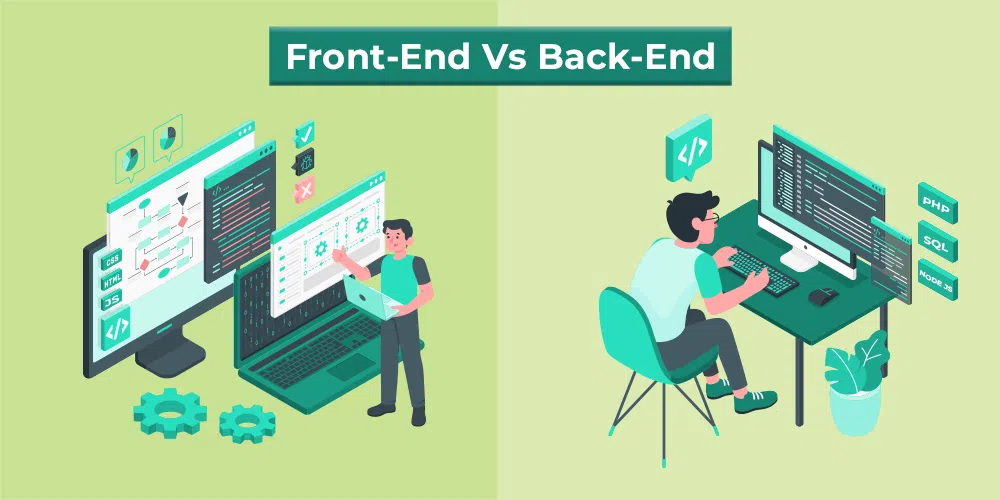If you’re starting a journey into web development, one of the first questions you’ll come across is:
What’s the difference between frontend and backend development?
Both are essential to building websites and web applications, but they do very different things.
Let’s break it down in simple terms and help you figure out which path might be right for you.
🚪 Think of a Website Like a Restaurant
Imagine you go to a restaurant:
The frontend is everything you can see and interact with—the menu, the decor, the waiter.
The backend is everything behind the scenes—the kitchen, the chef, the inventory system.
You don’t see the backend, but without it, nothing works.
🌐 What Is Frontend Development?
Frontend development (also called client-side development) is the part of the web that users see and interact with directly.
This includes:
Layout and design
Buttons and menus
Forms and input fields
Animations and page transitions
Responsive behaviour on mobile/tablets
✅ Frontend Tools & Languages (2025)
| Language / Tool | Purpose |
|---|---|
| HTML | Structure and content |
| CSS | Styling and layout |
| JavaScript | Interactivity and logic |
| React.js | Building modern UIs |
| Vue.js / Angular | Other popular frameworks |
| Tailwind CSS | Utility-first CSS framework |
| Figma | Design collaboration tool |
Frontend developers turn a design mockup into a functional, interactive webpage.
🧠 What Is Backend Development?
Backend development (also called server-side development) is the part of the web that users don’t see. It powers everything under the hood.
This includes:
Databases
APIs
Authentication (login/signup)
Payments
Server logic (e.g., order processing, search results)
✅ Backend Tools & Languages (2025)
| Language / Tool | Purpose |
|---|---|
| Node.js | JavaScript runtime for servers |
| Python (Django) | Web apps, APIs |
| PHP (Laravel) | Traditional backend apps |
| Java / Spring | Enterprise-level applications |
| MySQL/PostgreSQL | Relational databases |
| MongoDB | NoSQL document database |
| REST / GraphQL | API communication methods |
Backend developers build the logic and infrastructure that makes apps work.
⚖️ Key Differences at a Glance
| Feature | Frontend | Backend |
|---|---|---|
| Visible to users | Yes | No |
| Core languages | HTML, CSS, JavaScript | Python, PHP, Java, Node.js |
| Focus | User interface (UI) | Business logic, data processing |
| Common tools | React, Tailwind, Figma | Node, Express, MongoDB |
| Who interacts with it | End users | Developers, databases, APIs |
| Primary goal | Visual & interactive experience | Functional & secure experience |
💼 Career Paths and Job Roles
🧑🎨 Frontend Developer
Converts designs into functional interfaces
Focuses on UI/UX
Works closely with designers
Must know responsive design and accessibility
💰 Average Salary (2025): $70K – $110K/year (depending on location and experience)
🧑💻 Backend Developer
Builds APIs and handles databases
Manages authentication and server logic
Focuses on performance, security, and scalability
💰 Average Salary (2025): $80K – $130K/year
🧑🚀 Full-Stack Developer
A full-stack developer works on both the frontend and backend.
They understand the full lifecycle of a web app—from layout to server response.
Versatile and in high demand
Great for freelancers or startups
Often uses tools like MERN stack (MongoDB, Express, React, Node)
💰 Average Salary (2025): $90K – $140K/year
👨🏫 Which One Should You Learn First?
The right path depends on your goals and interests:
✅ Choose Frontend if:
You enjoy design, visuals, and interactivity
You love creating user-friendly interfaces
You want faster, visual results from your code
🧠 Frontend is often easier to see progress when you’re learning.
✅ Choose Backend if:
You enjoy solving logical problems
You’re interested in security and data
You like working with servers and APIs
🧠 Backend requires a deeper understanding of logic, databases, and architecture.
🧪 Real-World Example: A Blog Website
| Part of the Site | Frontend Role | Backend Role |
|---|---|---|
| Homepage layout | Designs UI with HTML/CSS | Pulls articles from database |
| Contact form | Creates input fields + validation | Stores form submissions |
| User login system | Creates login screen | Authenticates credentials, creates sessions |
| Blog post display | Formats text, images | Retrieves posts via API |
Together, frontend and backend developers make the site complete.
🔁 How Frontend and Backend Communicate
The frontend sends requests (like form submissions, button clicks) to the backend via:
HTTP requests
APIs (REST or GraphQL)
WebSockets for real-time updates
The backend processes the request and sends data (often in JSON) back to the frontend.
🔥 Trending Stacks in 2025
| Stack Name | Stands For | Use Case |
|---|---|---|
| MERN | MongoDB, Express, React, Node | Full-stack JavaScript apps |
| LAMP | Linux, Apache, MySQL, PHP | Classic CMS + PHP sites |
| JAMstack | JavaScript, APIs, Markup | Static sites with dynamic data |
| MEVN | MongoDB, Express, Vue, Node | Vue-based full-stack apps |
| Django + React | Python backend + React frontend | Modern web apps |
✅ Final Thoughts
Frontend and backend are two sides of the same coin—both are essential to building great websites and apps.
There’s no need to choose one forever. Many developers start on one side and eventually learn the other.
🎯 Focus on your interest first, master the basics, and grow from there.
With the tech world evolving fast, having a clear understanding of how frontend and backend work together will set you up for long-term success.












Recent Comments
No comments yet.